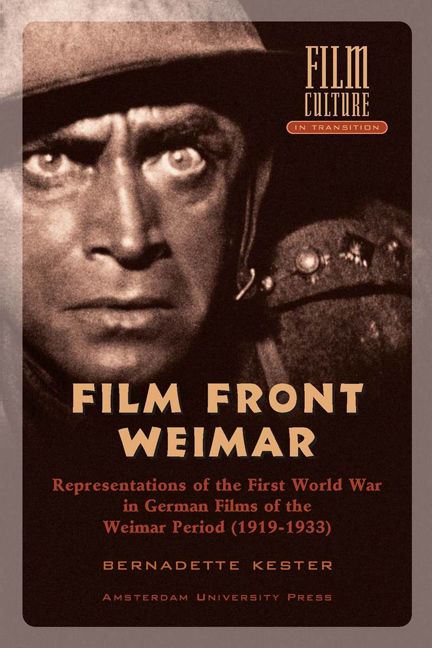 Filmfront Weimar
Filmfront Weimar Book contents
- Forntmatter
- Contents
- Preface and Acknowledgements
- Introduction
- Chapter 1 ‘Lehrreich Und Amüsant’ – Historical Films in the Period 1896-1933
- Chapter 2 ‘Die Legende von der Unschuld’ – Films about the Run-Up to the war, Especially 1914. DIE LETZTEN TAGE VOR DEM WELTBRAND
- Chapter 3 ‘Das Dokumentarische Gewinnt die Oberhand’ – Archival Footage and Constructions in War Films
- Chapter 4 ‘Wenn Wir Helden Wären, Wären Wir Schon Längst Daheim’– Realism and Anti-War Tendencies in Four Films
- Chapter 5 ‘Auf Dem Meere, Da Ist Der Mann Noch Etwas Wert’ – Films About the German Navy During The First World War
- Chapter 6 ‘Neid, Leid, Tränen – Das Ist Der Krieg’– Gender and War Films
- Epilogue
- Notes
- Credits Weimar War Films
- Archives and Libraries
- Bibliography
- Index of Names
- Index of Subjects
Chapter 3 - ‘Das Dokumentarische Gewinnt die Oberhand’ – Archival Footage and Constructions in War Films
Published online by Cambridge University Press: 15 January 2021
- Forntmatter
- Contents
- Preface and Acknowledgements
- Introduction
- Chapter 1 ‘Lehrreich Und Amüsant’ – Historical Films in the Period 1896-1933
- Chapter 2 ‘Die Legende von der Unschuld’ – Films about the Run-Up to the war, Especially 1914. DIE LETZTEN TAGE VOR DEM WELTBRAND
- Chapter 3 ‘Das Dokumentarische Gewinnt die Oberhand’ – Archival Footage and Constructions in War Films
- Chapter 4 ‘Wenn Wir Helden Wären, Wären Wir Schon Längst Daheim’– Realism and Anti-War Tendencies in Four Films
- Chapter 5 ‘Auf Dem Meere, Da Ist Der Mann Noch Etwas Wert’ – Films About the German Navy During The First World War
- Chapter 6 ‘Neid, Leid, Tränen – Das Ist Der Krieg’– Gender and War Films
- Epilogue
- Notes
- Credits Weimar War Films
- Archives and Libraries
- Bibliography
- Index of Names
- Index of Subjects
Summary
The importance of the idea of a ‘historically accurate’ and ‘ideologically sound’ representation of the past is shown by the reactions sparked by the historical film 1914. DIE LETZTEN TAGE VOR DEM WELTBRAND. Adapting the runup to the war for the screen on the basis of official documents had in the case of this film resulted in a theatrical and rather static approach dominated by studio sets and dialogue. But it was not so much the stageing that got reactions from the press but the contents of the dialogues: were the assertions made by the characters and their mutual relationships correct? Was the order in which the diplomatic manoeuvres took place altogether correct? The underlying question turned out to be whether the film's version of events corresponded at all with the various existing political interpretations represented by the newspaper critics.
From this chapter onwards, the emphasis will lie mainly on films dealing with the historical events that occurred at the battle front and at the home front during the war. The battle front in the trenches is the central topic of this chapter and of the next one. Representing life at the front of course called for a filmic approach that was totally different from the one used to represent diplomatic history. In both cases, the historical reality was so complex that it was not at all clear what was actually happening. People at the front often had no idea what was going on, while the press, citing ‘security reasons’, often provided the people back home with incomplete information. The films that were later made about these subjects served to reduce things to comprehensible and well-ordered proportions. 1914 was an attempt to recast the confusing history of pre-war diplomacy into an understandable sequence of events. But what archival footage and narrative strategies could be used to reduce the front experience to well-ordered and ‘acceptable’ proportions? What exactly was shown about the horrors, the mortal fear, the boredom and the daily realities of the trench experience, and what was left out? What kind of characters were introduced to represent the German, French, Russian or British soldier? What filmic means were used to represent both the historical course of events and the trench experience itself? These questions are the central concerns of this chapter and of the next one.
- Type
- Chapter
- Information
- Filmfront WeimarRepresentations of the First World War in German Films from the Weimar Period (1919–1933), pp. 87 - 122Publisher: Amsterdam University PressPrint publication year: 2002


